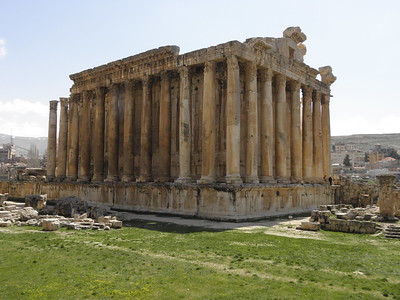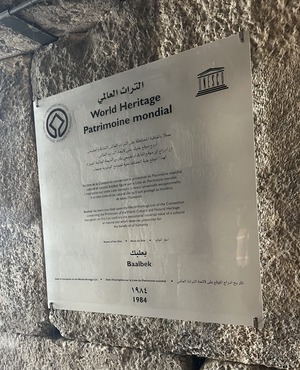Baalbek

Baalbek comprises the well-preserved remains of a Roman sanctuary.
With its colossal monuments and detailed stonework, it is considered one of the finest examples of Imperial Roman architecture. At the sanctuary, called Heliopolis at the time, Phoenician beliefs and the Greco-Roman pantheon were brought together. The site attracted many pilgrims.
Community Perspective: the most stunning WHS of Lebanon, very impressive for the height and solidity of the remains and its fine setting below the snow-capped mountains.
Map of Baalbek
Load mapCommunity Reviews
Triath

Visited in May 2023.
The WHO is located in the territory controlled by Hezbollah, so you need to be careful when planning your trip, there may be bombings in the surrounding area.
I got here by bus from Beirut, not without adventures, I had to pay extra and change to another bus, but you can do without a taxi.
Mysterious in its monumentality, the temple complex was built on the easternmost edge of the Roman Empire. A grandiose sacred complex was built here in the first century AD, which is considered to be one of the largest in the ancient world. The temple-sanctuary of Jupiter on a massive stylobate, the temple of Bacchus, the temple of Venus, there was also a temple of Mercury on the neighboring hill, but it did not survive.
At the same time, it is not very clear who built it, for whom, why exactly in this place. Even dating is done by indirect signs. Meanwhile, it is obvious that a pilgrimage center of such a scale had to have an imperial significance. Perhaps a role was played by ancient traditions of religious worship in Heliopolis, as Baalbek was called under the Romans.
In the nearby quarry, a giant thousand-ton block is still preserved, which was never completely processed, and in 2014 it was further excavated by archaeologists.
The temple inspires respect, first of all, for its scale and a fairly good degree of preservation.
Martina Rúčková

Save it for the last if you can, because not only is Baalbek the most stunning WHS of Lebanon, but even after couple of hundred sites visited, many many Roman ruins included, it still blew our minds and exceeded all our expectations. Just wow.
Baalbek site, located inside Baalbek, the administrative centre of the Bekaa valley and one of the places you wlll be advised against travelling to in Lebanon, contains spectacular ruins of Roman temples of Bacchus, temple of Jupiter and temple of Venus. They were built on a magnificent scale, 23 metres high, with columns 2.2 metres in diameter. The sheer scale of everything is mind-blowing. I enjoyed climbing on top of one of the large Corinthian-style column head. Another awesome thing, you can walk around, climb wherever you want, without some nasty local guard whistling at you to shoo away (greetings to Delphi). There are two museums on-site: one in the medieval tower and another in an underground tunnel on your way back. There's also a small tourist info centre by the ticket office, though at the time of our visit it was blessingly vacant with some booklets of other sights, in Arabic only.
We got there with a car, passed some checkpoints on the way, but nobody checked our passports, the soldiers just waved us away with attests to the calm situation in the area. No Hezbollah check points I've read about in other blogs. But you will feel it's a Hezbollah territory, especially by the souvenir vendors offering their prime product: a Hezbollah t-shirt. There's a parking spot by the site and from there it's about 500 metre walk to the entrance. The site had a number of tourists, but they dispersed due to the sheer size of it. It was the highlight of our trip to Lebanon and I really enjoyed it. If you're looking for a reason to visit the country of the cedar tree, this is it.
Els Slots

I went on an organized day tour from Beirut to Baalbek - one that efficiently also encompasses the WHS of Anjar (and some wine tasting at Ksara, but I am not fond of that). We were a group of six, of which I was the only one having come to Lebanon as a tourist. The others were here for work or study.
Baalbek lies quite deep into the Bekaa Valley, which means that we first had to cross Mount Lebanon. It had been snowing until last week, and snow was still visible beside the road at the mountain pass. The road is not in great shape and is as busy with traffic as everywhere I have seen so far in Lebanon. The Bekaa is a fertile valley and the main agricultural zone of Lebanon. There were lots of fruit and vegetable stalls next to the road, as well as hanging slaughtered animals. Remarkable I also found the numerous tents of Syrian Bedouins, who apparently come here to work as agricultural labourers. The current city of Baalbek mostly has a Shi'ite population, and they quite recently built a glittering new mosque not far from the archeological site. In town, there also is a large Palestinian refugee camp.
We started the tour with a quick visit to a quarry for the Baalbek site, at which it becomes clear how big the monoliths were that were used for construction. The Baalbek complex begins with the Temple of Venus, just outside the core zone and mostly in the rubble. Then you enter the main site via an impressive stairway, the ceremonial entrance.
Behind that, the site opens up in all its splendour. The most impressive thing about Baalbek was the density of the remains and their height. The Temple of Bacchus looks almost complete (at least on the outside). There are finely sculptured details like the lion-headed gargoyles and the motifs on the side of the pools used for ritual washing.
The circuit ends at an underground passage. This holds the badly lit and moist Baalbek museum. I had a quick look but could not "warm up to it". The best parts are in the National Museum in Beirut anyway.
Frank
UNITED STATES OF AMERICA - 16-Jan-09 -
July 2003,a stage and seats were being set up for a play during my visit so some of the site was unaccessable,but the two main temples of Jupiter and Bacchus were magnificent to see as as grande in size to behold,its almost unimaginable the size of the Jupiter Temple during its heyday as is evident buy the 6 remaining 67 foot high columns that still stand,when walking around the Temple of Bacchus makesure to look up under the outside columns and notice the intricatly carved rooftop colonaide as i said i was there in july blazing hot but maby 10 people there the whole time during my visit,a must see
Solivagant

Baalbek is the great “must do” site if you are in Lebanon. It is situated not far off the road across the mountains to Damascus and could conveniently be taken in on such a journey.
This detour takes you into the “infamous” Bekaa Valley. We were there in 1999 and, apart from passing under archways carrying pictures of Ayatollah Khomeini, we saw nothing else to remind us that this is the heartland of Hezbollah in Lebanon. Everything was very relaxed.
The ruined city is primarily Roman but had Phoenician and Greek origins. The height and solidity of the remains is very impressive. The setting below the snow-capped mountains is also rather fine. We were there in April and, although we had a rentacar, the road west over the mountains to the Cedars of Lebanon WHS was still closed by snow but should be an interesting journey a month or so later. A couple of hours to wander round should be enough for all but “Roman Architecture buffs”.
Community Rating
- : Westwards Walter Stanislaw Warwas Joyce van Soest Juropa Stetrab Persian Globetrotter Dutchnick Christravelblog MoPython Little Lauren Travels Rodinia Rvieira Martina Rúčková Hadrianus Lukasz Palczewski Ivan Rucek Philipp Peterer
- : Tarquinio_Superbo Randi Thomsen Svein Elias Alexander Lehmann Jeffrey Chai Ran Hanming João Aender Mikko Naim Y Krijn Juha Sjoeblom
- : Eric Lurio Jonas Hagung Alexander Barabanov George Gdanski Philipp Leu Zoë Sheng Zach Triath Els Slots
- : Axel Fries Vernon Prieto Dachangjin3 Bergecn
- : Solivagant Ammon Watkins
- : Harry Mitsidis
Site Info
- Full Name
- Baalbek
- Unesco ID
- 294
- Country
- Lebanon
- Inscribed
- 1984
- Type
- Cultural
- Criteria
-
1 4
- Categories
- Archaeological site - Ancient Rome
- Link
- By ID
Site History
1984 Inscribed
Site Links
Unesco Website
Official Website
Related
Connections
The site has 21 connections
Constructions
History
Human Activity
Individual People
Religion and Belief
Timeline
Trivia
Visiting conditions
WHS Hotspots
Visitors
168 Community Members have visited.
The Plaque
 (photo by Aspasia)
(photo by Aspasia)